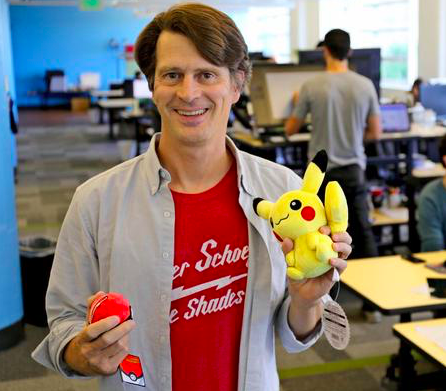
This week, students in the A. Richard Newton Lecture Series had the opportunity to hear a fireside chat with John Hanke—a Cal grad and CEO of Niantic, which produced the wildly popular app Pokémon Go—moderated by Dr. Bjoern Hartmann, EECS professor and director of the Jacobs Institute for Design Innovation at UC Berkeley. The two tech moguls discussed Hanke’s early excitement for technology, his formative experiences at UC Berkeley, and his involvement in mapping and augmented reality made him an inspiring and insightful addition to the series. 
Early Life and Background
John Hanke grew up in a small town in West Texas with a humble population of 1,000 people. Hanke proclaimed that there was nothing to do in a town that only had one blinking light, a school system, and a Dairy Queen, so he found ways to entertain himself. His solution came in high school when he walked into a math classroom and seeing a personal computer for the first time, with upper classmen huddled around it playing a Star Trek game. Unlike his peers, however, Hanke wanted to understand how the computer itself worked.
The young computer enthusiast saved up all his money mowing grass over a summer to buy a computer and learn how to program, writing a variety of rudimentary and complex codes.
“Programming and computers were my passion,” Hanke said.
The sources of much of Hanke’s inspiration were science fiction authors like William Gibson and Daniel Suarez. Hanke said he found many of the visions in these works of literature and films to be foundations for real-world, modern advances in technology.
Education at Berkeley and Inspiration
In 1994, Hanke joined the UC Berkeley community and began working towards his goal of creating programs in proximity to Silicon Valley. In his application to the Haas School of Business, Hanke wrote that he wanted to build applications that encouraged people to meet up in the real world. He wanted to imagine applications that could engage in real, historical places, and would help people understand and experience cultures through games and simulations.
Berkeley provided an ideal environment for Hanke, who took advantage of the connections Cal had to offer, networking with entrepreneurs and speakers who would visit the campus. Hanke continued with this same enthusiasm and worked to develop massively multiplayer online role-playing games with a startup called Archetype Interactive. The startup received an acquisition offer, and Hanke signed a $10 million offer the day he graduated.
Google Earth
Hanke’s insight from creating gaming universes with co-habitable environments meshed well to his visions for mapping and spatial information.
At the time, the foremost mapping service was Mapquest, and its 2D browser experience didn’t allow for the panning, moving, and zooming modern users have come to depend on. Hanke recalled realizing that 3D subsystems were not just a distant vision, but a feasible future, because a few inflection points were happening at the same time.
Networks were growing faster, imaging satellites were being launched, digital cameras were being used for aerial photography—all of this lending to the possibility of photorealistic earth technologies. As one of the co-founders of the data firm Keyhole, Hanke worked to develop mapping technology and caught the attention of Google, who then bought Keyhole in 2004.
After the acquisition, Hanke worked closely with Google’s “Geo” division, helping integrate Keyhole technology into Google Earth and Google Maps.
Ingress to Pokémon Go
 Although Niantic, Hanke’s current company, is best known now for bringing users Pokémon Go, the original and lesser known augmented reality game was Ingress. When Hartmann asked what the key ingredient to Pokémon Go’s runaway success, Hanke replied that it was changes in technology, better geolocation and handsets, and greater network connectivity.
Although Niantic, Hanke’s current company, is best known now for bringing users Pokémon Go, the original and lesser known augmented reality game was Ingress. When Hartmann asked what the key ingredient to Pokémon Go’s runaway success, Hanke replied that it was changes in technology, better geolocation and handsets, and greater network connectivity.
“Iteration is the name of the game, and you get better every time you rebuild something,” Hanke said.
Hanke explained that everything got better the second time around with Pokémon Go, and connecting with the franchise’s intellectual property revealed how many people grew up with Pokémon and had sentimental attachments to it.
The Future of Augmented Reality
Augmented and virtual reality technologies are moving into an interesting time, Hartmann remarked, where companies are using these features for more than just games. Hanke noted that major media giants are beginning to integrate AR and VR heavily into the user experience, even developing “mixed reality,” as with Microsoft. The CEO said he was happy to see the industry applying itself to building new devices that are more integrated into life.
“Augmented reality devices enhance the world around you,” Hanke explained.
Advice for Entrepreneurs
- Anticipate where current technologies are going to lead the industry.
- Everyone has a wide range of skill sets to contribute to entrepreneurship.
- Be passionate and skilled in a variety of interests.
- Engage with your environment and take advantage of opportunities at Cal.
________________
John Hanke’s love for bringing futuristic technologies to life, his dedication to seizing the opportunities around him, and willingness to grow and change with the industry made him another great example of a model entrepreneur.
